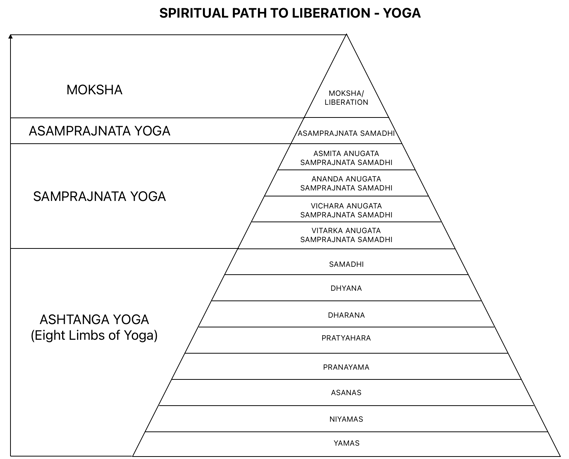Yoga and the spiritual path to liberation
Are my practices in accordance with the standards set by the scriptures?
These days, asanas have become almost synonymous with yoga. While asanas are indeed a component of yoga, the scope of yoga goes far beyond them. The ultimate goal of yoga is liberation. Asanas should be practiced with this purpose in mind, rather than solely for material or health benefits. Only when asanas are performed with this higher purpose do they truly become yoga; otherwise, they are not much different from any other form of physical exercise.
Prayatna saithilya ananta samapattibhyam - Patanjali yoga sutras 2.47
The sutra above provides guidance on the proper way to practice asanas. The physical movements should be performed with minimal effort, while the mind remains absorbed in the infinity during the practice. This clearly shows that asanas are not just physical exercises; they are meant to help guide the mind inward. In the previous post (The Beginning of Spirituality), I mentioned that the mind tends to stay outward due to the afflictions. Unless you begin working on these afflictions, you cannot practice asanas in their true essence.
rajayogam vina prthvim rajayogam vina nisa
rajayogam vina mudra vicitrapi na sobhate - Hatha Yoga Pradipika 3.126
Hatha Yoga Pradipika, the original text on Hatha Yoga, also emphasises that without the goal of liberation and a commitment to addressing your mental afflictions (Raja Yoga), the practice of asanas, pranayama, mudras, or any other practices such as kundalini practices will not provide any spiritual benefit.
Moreover, incorrect practice of pranayama or mudras can lead to mental disorders, as they involve working directly with prana without first preparing the mind. Swami Vidyaranya, in his work Jivan Mukti Viveka, illustrates this with an analogy: practicing hatha yoga without working on the mind is like trying to restrain a rogue elephant with the fragile fibers of a lotus stalk—it is destined to fail.
The most important thing is working on the mental afflictions. Once you start working on them, every practice you undertake will support your spiritual journey. In fact, it is possible to become a great yogi without ever practicing a single asana.
I understand the goal, but what is the path to achieve it?
Yoga Darśana presents a well-defined, systematic approach to guiding the mind inward, progressively leading towards the ultimate goal of liberation:
Start with Yamas and Niyamas: These foundational practices establish the groundwork for all subsequent practices.
Advance to Asanas, Pranayama, and Pratyahara: Only a mind purified by working on Yamas and Niyamas can practice these satisfactorily. The first five limbs are external practices.
Move to Internal Practices: Once the mind is restrained from going out by the external practices, you direct the mind to the internal practices - dharana, dhyana and samadhi.
Progress to Samprajnata Yoga: With the ability to attain Samadhi, the yogi moves on to Samprajnata Yoga.
Asamprajnata yoga and liberation. After accomplishing the highest spiritual experience, the yogi advances to asamprajnata yoga, ultimately ending in liberation.
Each practice is clearly defined, and success at each stage is marked by the development of Siddhis. Siddhis are not mere supernatural powers but milestones on the spiritual path, leaving no room for ambiguity.
The practices outlined may seem daunting to beginners. The intent here is to raise awareness about the spiritual path to avoid being misled by individuals who exploit genuine students. Many popular practices today are based on blind traditions, promoted by those who have neither studied nor practiced according to the scriptures. Understanding and succeeding in these practices requires serious study and dedicated commitment.


What is the right attitude for practicing?
We all have various responsibilities in life, and we are often faced with unexpected challenges. Consequently, we might put our spiritual practices on hold, waiting for an ideal time to resume. It’s important to realize that uncertainty will always be there in one form or the other, and our responsibilities will never completely disappear. We should discharge our duties to the best of our ability and work towards our spiritual future.
yogastah kuru karmani sangam tyaktva dhanajaya
siddhya asiddhou samo bhutva samatvam yoga ucchyate - Bhagavad Gita 2.48
Krishna’s guidance to Arjuna on the battlefield provides profound insight into the attitude we should adopt toward our practices. We should practice sincerely, without being attached to the outcomes of our actions, treating both success and failure in spiritual practices alike - this equanimity of mind is yoga. Ultimately, it’s not the duration, type, or intensity of your practice that matters most, but the attitude with which you approach it.
Sa tu dirghakala nairantarya satkarasevito dridabhumih - Patanjali yoga sutras 1.14
Patanjali guides a genuine student in the above sutra - Those practices carried on for a long time, without any interruption and wholeheartedly gets firmly established. Given that we carry deep-rooted mental impressions (samskaras) of afflictions, it is essential to develop new spiritual samskaras through consistent practice. This approach will initially weaken and eventually remove these afflictions. Even for those deeply committed, success takes time.
It is a blessing to be born as a human. It is not wise to waste it, as you may not have another chance to experience such a birth.